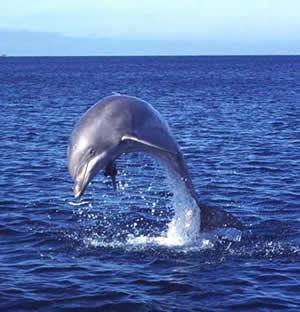Dolphins in Mexico's Pacific
Dolphins

Dolphins are not fish. They are mammals. Thus, they have teeth, are warm-blooded, have a four-chambered heart, and nurse their young from mammary glands. They even have hair - but not a lot! The mothers feed milk to their young for months and the young calf stays with the mother and other dolphins in the pod for years. Dolphins have one blow hole on top of their head and, depending on the species, age and physical condition, can stay submerged for more than 20 minutes. They can travel as much as 80 or 90 miles in a day . Their smooth and oily body enables them to streak through the water with great efficiency and speed. The up-and-down motion of their tail propels them through the water and allows them to jump in the air. They appear to 'enjoy' riding the bow of fast moving vessels, where they can be pushed by the wave and surf effortlessly. Most societies revere or at least respect dolphins as highly intelligent animals. The Japanese, however, prefer them sliced and served with wasabe… The Faeroe Islanders are also partial to dolphin steak. They slaughter them by the thousand every year. Man is the dolphin's greatest predator. More than 100,000 individuals die each year as a result from hunting or being caught in fishing nets and drowned. Sharks take their toll, especially in areas of high concentration (sharks that is) like South Africa and Australia. The other major predator are other dolphins; the bigger ones preying on their smaller cousins. At the top of this chain are the Orcas or Killer Whales (nevertheless dolphins), who like to eat them without the wasabe. Most dolphins have curved dorsal fins and flippers that vary in size and shape from one species to the next. Their beaks are well defined, and they all generally have small, conical, sharp teeth arranged in both the upper and lower jaw.
Dolphins are cetaceans, a group which includes all whales and dolphins. Some cetaceans, like the blue and humpback whales, are baleen whales and have horny plates hanging from their upper jaw. These are used to strain krill from the ocean. Others, like dolphins, orcas and porpoises are 'toothed whales' and thoroughly carnivorous.
Within the group of toothed whales, there are several subgroups: oceanic dolphins (32 species), river dolphins (5 species), sperm whales (3 species), beaked whales (19 species), beluga and narwhal (2 species) and porpoises (6 species). They all use echolocation as a means of navigation and vocalize as a means of communication. As far as Acapulco is concerned, if you take a boat out of the bay, you are fairly likely to see dolphins, riding the bow wave, swimming along side or jumping. The best time is sunrise or sunset. It is a wonderful sight and should not be missed. The types you are most likely to come across are: the Common, the Spotted and the Spinner.
And then again if you don't fancy the idea of getting up before dawn or are nervous about being out at sea at night, you might trot along to CiCi on the Costera and swim with the ones in the aquarium. They are are spinner dolphins.
